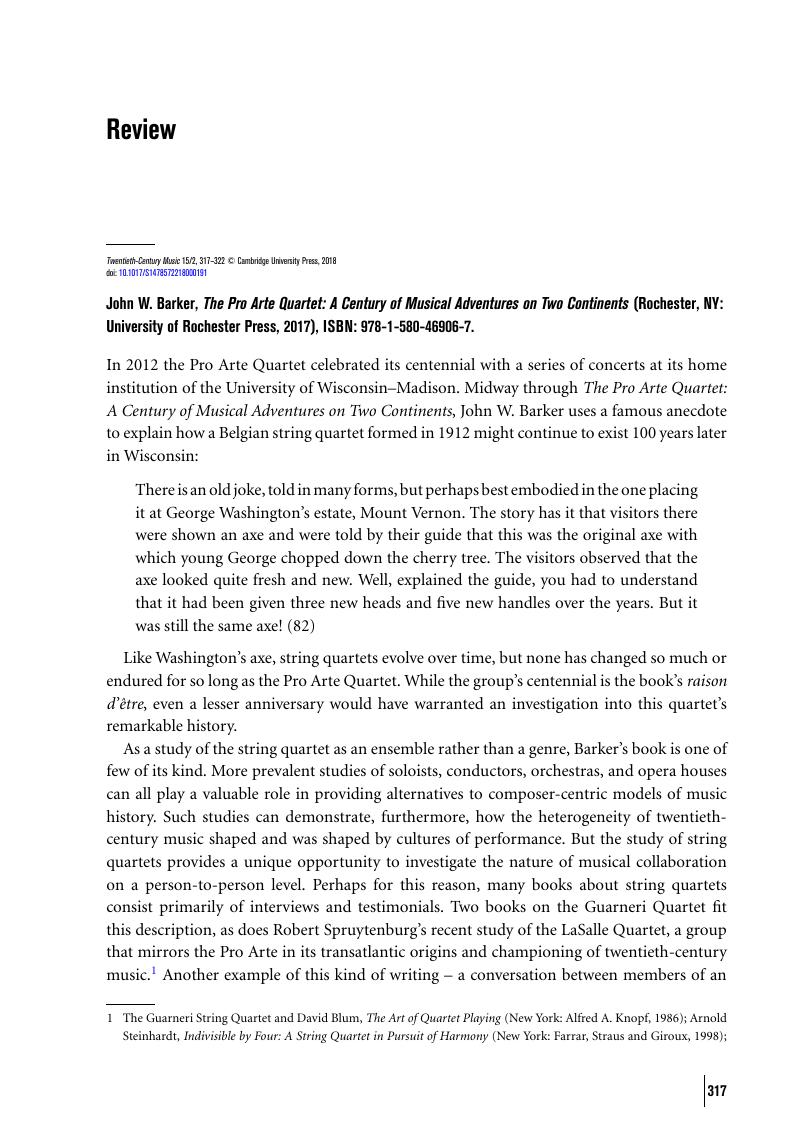No CrossRef data available.
Published online by Cambridge University Press: 15 August 2018

1 The Guarneri String Quartet and Blum, David, The Art of Quartet Playing (New York: Alfred A. Knopf, 1986)Google Scholar; Steinhardt, Arnold, Indivisible by Four: A String Quartet in Pursuit of Harmony (New York: Farrar, Straus and Giroux, 1998)Google Scholar; Spruytenburg, Robert, The LaSalle Quartet: Conversations with Walter Levin, trans. Howe, Richard (Woodbridge: Boydell Press, 2014)Google Scholar.
2 Le Guin, Elisabeth, Boccherini's Body: An Essay in Carnal Musicology (Berkeley and Los Angeles, CA: University of California Press: 2006), 234–53Google Scholar.
3 Blum, Martha, ‘The Pro Arte Quartet: 50 Years’, in Blum, Martha and Becknell, Nancy, The Pro Arte Quartet: 50 Years; The Wingra Woodwind Quintet: 50 Years, (Madison: University of Wisconsin Madison School of Music, 1991)Google Scholar; Anne Van Malderen, ‘Historique et réception des diverses formations Pro Arte (1912–1947): Apport au répertoire de la musique contemporaine’ (PhD diss., Université Catholique de Louvain, 2012).
4 Though it may not have been feasible, the sections on recording would have also benefited from a multimedia component, perhaps in the form of a CD or an affiliated website. When, for example, Barker describes the ‘Viennese warmth and inflection’ of the Pro Arte's recordings under Rudolf Kolisch (164), it would be helpful to hear those qualities firsthand, rather than having to take Barker's word for it.
5 See, for example, Meyer, Felix, Oja, Carol, Rathert, Wolfgang, and Shreffler, Anne, ‘Introduction’, in Crosscurrents: American and European Music in Interaction, 1900–2000, ed. Meyer, Felix, Oja, Carol, Rathert, Wolfgang, and Shreffler, Anne (Woodbridge: Boydell & Brewer, 2014)Google Scholar.
6 Spruytenburg, The LaSalle Quartet, xiv.
7 Levin, Walter, ‘Immigrant Musicians and the American Chamber Music Scene, 1930–1950’, in Driven into Paradise: The Musical Migration from Nazi Germany to the United States, ed. Brinkmann, Reinhold and Wolff, Christoph (Berkeley: University of California Press, 1999), 322–39Google Scholar
8 Jay, Martin, ‘The German Migration: Is There a Figure in the Carpet?’, in Exiles and Emigrés: The Flight of European Artists from Hitler, ed. Barron, Stephanie with Eckmann, Sabine (Los Angeles: Los Angeles County Museum of Art, 1997), 326Google Scholar.
9 Kolisch's views on the relationship between analysis and performance have been explored in two recent articles: Mattes, Arnulf Christian, ‘“Keine Rührung – Erkenntnis!” The Aesthetics of Espressivo in the “Performance Theories” of Arnold Schoenberg and Rudolf Kolisch’, Swedish Journal of Musicology 95 (2013), 109–20Google Scholar; Shreffler, Anne and Trippett, David, ‘Rudolf Kolisch and the New School for Social Research’, Musiktheorie: Zeitschrift für Musikwissenschaft 24/3 (2009), 199–209Google Scholar.